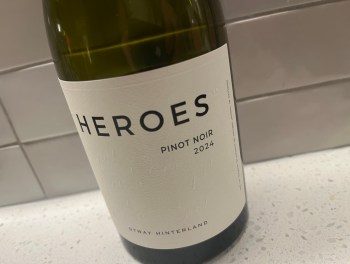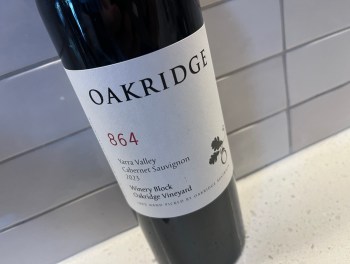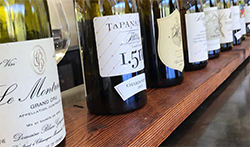Following on from Monday’s article on blends, I thought it only fair to back it up with a selection of the better white and red blends to pass the desk recently.
No shortage of interest in this collection either…
Benfield & Delamare 2006
An oddity. The Benfield & Delamare vineyard was/is (it’s hard to know what happened) a tiny, close planted plot of Merlot/Cabernet Sauvignon and Cabernet Franc in the heart of Martinborough. They made a single Bordeaux blend wine and for mine, it was a beauty – hence why I bought a six pack many years ago. I still have a few left in the cellar and every bottle has been a winner. Still high levels and great colour – dark ruby with a little bricking. It’s a beautiful, elegant, finely tannic claret-esque herbal dry red. There’s a licoricey, withering blackness to the tannins too. It’s still herbal, still leafy and not easy. But there’s a beauty here, an understated spice and weight that’s not unripe at all. And it’s so perfectly youthful. Simply, a delightful drink that could be 2012 not 2006. Best drinking: Good now and for plenty of years yet (5 at least). 18/20, 93/100. 13%. $60ish back in the day. Would I buy it? Glad I did.
Latta Rattlesnake Blanc 2018
Owen Latta’s wines are exciting, and this is clever wine. A blend of western Victorian fruit from 5 different skin contact parcels, with varieties inc. Viognier, Pinot Gris, Pinot Noir (kept on Gewurz skins) and Sauvignon Blanc. All juice is kept on skins from vintage until Feb this year. After such extended skin contact, it’s proper orange coloured (with a little blush) too. Though underneath it’s dry, mandarin drenched and ripe – flesh to go with the phenolics. There’s some oxidative tang and a whisper of mothballs, but otherwise just lots of mandarin, with a really plump mouthful of stonefruit. That palate generosity is pretty joyful, though you’d hardly call it an easy drink. But it’s clean and the layers of flavour alone are worth a glass. Best drinking: Now. 17.7/20, 92/100. 13%, $35. Would I buy it? At least a glass.
Soumah The Butcher 2016
Soumah’s recent full-bodied Yarra red releases have been a big step up, even from tricky vintages like 2016. This blend is 44% Syrah, 33% Cabernet, 23% Nebbiolo – all from the Yarra – that spends 18 months in 50% new French oak. Serious intentions. It’s a hunky wine too, the dry ’16 vintage bulking it up and drying it out. Cherry Ripe, hints of dried leaf and black pepper it’s a masculine style that gets denser on the palate after the attractive nose. It’s perhaps a little too dense and grippy wth the black leafy fruit eventually ending up with black liqueur warmth to finish. What I do like is that you can see all the elements. It’s not a regional classic, but the ‘cool climate heft’ here wouldn’t be out of place in a modern Tuscan Sangiovese/Cab (as an analogous style). I found myself enjoying it more than expected. Best drinking: Now and for up to 15 years. 17.7/20, 92/100. 14.5%, $45. Would I buy it? A glass or two.
d’Arenberg The Ironstone Pressings 2016
There’s been a winemaking shift in recent vintages at d’Arenberg, and the wines are cleaner and softer than they’ve been in years. That’s not always a good thing, but the little polish makes these easier drinks. A blend of 70% Grenache, 25% Shiraz and 5% Mourvedre. There’s still the trademark grippy grainy d’Arenberg tannins, underplayed oak, and lots of earthen, plum jam fruit. Savoury and substantial. Heart and hearty if a bit warm. Quality wine. Best drinking: Now to ten years plus. 17.7/20, 92/100. 14.5%, $75. Would I buy it? A glass, maybe two.
d’Arenberg The Ironstone Pressings 2015
A step back in vintage and style. Here, it’s McLaren Vale Grenache (48%), Shiraz (47%) and Mourvedre (5%). You can see all the inputs here too – that low intervention d’Arenberg style gives this grip and grime and earth, the Grenache fruit gives this smooth raspberry fruit, the purple fruit behind it all Shiraz. The only tricky part is the murky, sweet and sour earth edges. Still, this has so much heart, lots of fruit, lots of flavour and tannins. It’s just lacking the polish of the ’16. Best drinking: Now to 10 years plus. 17.5/20, 91/100. 14.3%, $70. Would I buy it? A glass.
Hugh Hamilton Black Ops 2016
From the Hugh Hamilton ‘Dark Arts Collection’ that is all about odd blends (like a herbal oddball Cabernet Sauvignon/Sauvignon Blanc), with this a mix of 66% McLaren Vale Shiraz and 34% Saperavi. Does the Saperavi work? It sure gives this an endless, ‘watch that black hole’ deep richness. Plush purple fruit, with a grippy, licoricey, thick black fruit palate. Has power and bitterness, oak and heft. It’s possibly too hefty. But we all know someone who just wants a red wine that they can chew on. Best drinking: Whenever. Up to a decade maybe. 17.5/20, 91/100. 14.5%, $32.50. Would I buy it? Not personally.
Mas de Daumas Gassac Blanc de Raisins Blanc 2013
I absolutely loved this wine when first tasted at the winery three years ago. A blend of 30% Voignier, 25% Chardonnay, 20% Petit Manseng, 15% Chenin Blanc, 15% other varieties. A waxy, layered white with a whole assortment of fruit on the palate – apple pie, guava and lemon apricot. It’s all fruit though, low acid and just a fraction broad to finish, even though it’s not strictly fat. I was expecting a bit more fireworks beyond fruit salad fruit, but pleasurable and a lovely texture. Best drinking: Now. 17.5/20, 91/100. 13%. Would I buy it? Probably not at this stage. I should have bought the red.
Yangarra Blanc 2018
Yangarra’s first attempt at a proper Chateanuef Blanc style and incorporating varieties that they’ve brought in (hello Grenache Blanc). Round of applause for Yangarra’s effort as a start. The blend is Grenache Blanc, Clairette, Roussanne, Picpoul, Bourbolenc. Of that lot, the Roussane is picked separately on 6th March, the rest all picked on 18th March and co fermented in ceramic eggs, with no acid or sulphur additions (save for so2 at bottling). Spends a few months on lees in eggs and bottled July 2018. I’m only just geting to it now and it could do with more time to build. This is a gently textural, appley style with a phenolic tang, preserved lemon and grapefruit with a long finish. It’s just a bit neutral for big points now, but all the signs are there for a hero white wine of the future. Best drinking: It could well do with some more bottle ageing. I’d love to see this style with some skin contact and more time on lees. SO much potential. 17.5/20, 91/100+. 13%, $25. Would I buy it? I’d drink a few glasses easy.
Hugh Hamilton Three-Card Monte 2016
Now it’s 44% Shiraz, 41% Cabernet Sauvignon and 15% Montepulciano all from McLaren Vale. Rhone, Bordeaux and a quick flight to the Abruzzo (in spirit). The appeal again is polished purple black fruit, with chocolatey oak and dark tannins, it’s grippy, it’s oak coiffed and it’s substantial, if a bit raw. Lots of dark plush blackberry flavour though, and it’s firm and dark. Good, substantial red wine. Best drinking: Over the next ten years. 17/20, 90/100. 14.9%, $32.50. Would I buy it? Not really.
Pikes The Assemblage Shiraz Mourvedre Grenache 2016
Clare Valley red blend from Polish Hill River estate fruit. I put this in the fridge after a 35C day and it looked all the better. Red berries, vanilla bean oak, then a mid weight, fleshy, yet still tannic in an old school Aussie way. Perhaps a little raw. But it fills you up with that knockabout, yet really substantial style. Good value. Best drinking: I’d like to see this in a year. Then for up to eight years. 17/20, 90/100. 13.5%, $24. Would I buy it? A glass.
Temple Bruer The Agonist Cabernet Sauvignon Merlot 2017
Organic McLaren Vale red from Temple Bruer and such a substantial wine. Deep mulberry red, the style minty and chunky and ripe. The tannins and alcohol are a little intrusive (and it’s minty) but there’s so much flavour here. Deep, minty, fudgey flavour. It’s not subtle, but again a lot of wine. Best drinking: Leave it for a year or so and reap the rewards. Will be alive in eight years easily. 17/20, 90/100. 14.5%, $35. Would I buy it? Maybe a glass.
Voyager Estate Sauv Sem 2017
Classy Margs blend in solid form here. A twist of herbs, a little passionfruit, the style snappy and varietal and with a palate that is ripe enough to be gentle and round but crisp enough to finish with acid vitality. It’s not particularly intense or delineated, and indeed the grassy edge is just a little obtuse, but an enjoyable fresh wine. Best drinking: Now. 17/20, 90/100. 13%, $24. Would I buy it? A glass or so.
Help keep this site paywall free – donate here









4 Comments
Hi Andrew, your parenthesis around ‘cool climate’ and Yarra Valley leads me to an interesting point that is worth of further discussion: what really classifies as ‘cool climate’?
If we look at the Yarra, it averaged 32C in January, with 5 days over 40C max, while in February the ave max was 29C. That doesn’t sound cool climate to me. Coonawarra, which also loves to add ‘cool climate’, averaged 31C in Jan and 28C in Feb. I call that hot.
So while ‘cool climate’ is a favourite marketing term, maybe more truthful descriptions would be: ‘bloody hot’, ‘very hot’ and ‘not quite so hot’.
An article on the vagaries of the term would be great.
Yes. In 2016 the Yarra was anything but cool climate. Ditto 2019. That said, if you average out the whole growing season it’s still cool climate (for now).
I’ll endeavour to explore in greater detail at some point.
http://www.raymondchanwinereviews.co.nz/features/h-martinborough-merlotcabernet-2008-and-2009
Great to see the vineyard lives on JD!